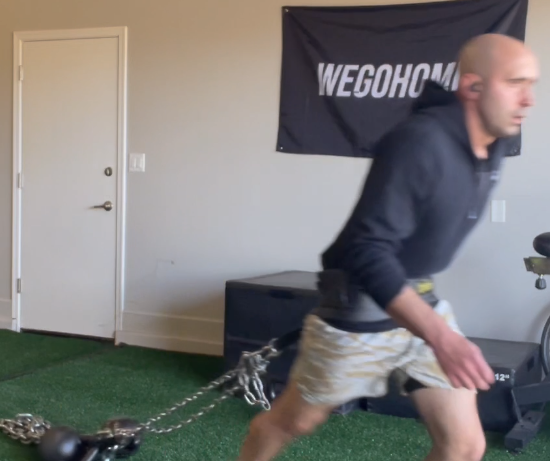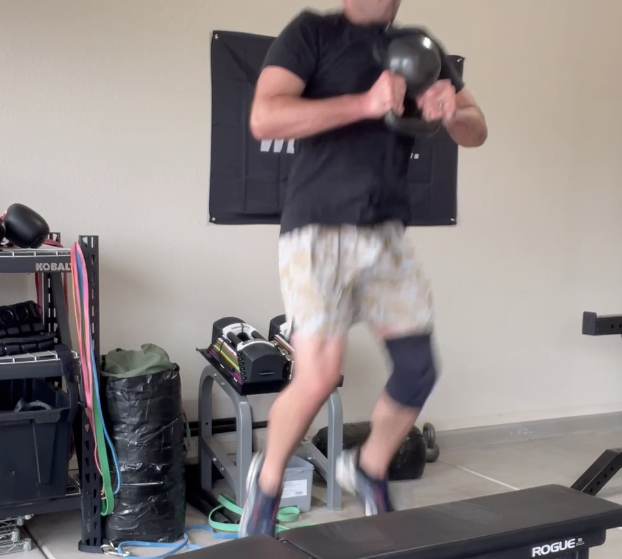Why the sled is one of the best tools for First Responders and Tactical Populations to improve running and aerobic capacity.
Key Takeaway
The sled is one of the most versatile tools that should be in every training facility that focuses on training First Responder/Tactical Populations. Almost any training goal can be developed by proper use of loading, distance, speed, cadence of reps, or even timed sets.
When properly combined with sprint/tempo work, the sled can also be used as a solid substitute for “Long Slow Distance” (LSD) runs for older populations where wear and tear could be a limiting factor in their training.
Traditional Running Programs
Typically traditional running programs will have one day of speed work, one day of tempo work, and then one long run day. These aren’t hard definitions as these training days will flex based off of the actual race distance of the athlete.
To keep things simple:
Speed Day: Shorter distance, faster than race pace
Tempo Day: Plus or minus 10% of of race pace held for sustained distances or time.
Long Slow Distance Day: This would be your Zone 2 run, heart rate anywhere between 115-140bpm for several miles or anywhere between 30-90 minutes (or longer).
Drawbacks of Typical Running Programs
If you’re a pure endurance athlete this kind of programming might be the perfect for you. Especially if you’re young and you’re getting closer to your athletic event. In fact, the general set up above has been used by pure endurance athlete for ages with a proven success record.
However, if you’re a First Responders/Member of a Tactical Population- you’re somebody that needs both a fair amount of strength and conditioning. Combine that with men and women who have years of wearing gear for hours on end, stressful shifts, and just normal aging sometimes programs like this just aren’t the best fit.
There is nothing inherently wrong with distance runs. However, running is a high impact activity. There is a range, but on each stride it is roughly 3-5 times the runner’s body weight on each step during the typical jog. If you extrapolate that out over long distances and accumulation over several weeks this can add up. Combine this with even a sensible strength training program and you might start to run into recovery issues.
With that said…first responders (and really anyone) still need to be able to run. Typically, our tactical heroes run fast for shorter distances with intermittent periods of moderate paced movements while under load. Street cops also run at near maximal speed while in gear. You can see this during a foot pursuit, where these events often end with a fight.
How do we train this, without needless wear and tear, and complement our strength training and/or self defense training, and make a less injury prone Hero? The general outline:
Day 1: Speed Work
(In between these days are your strength focused sessions, or complex days. Check earlier articles for examples)
Day 4 or 5: Sled Work- LSD Focus
Day 1: “Speed” Work
One way we can mitigate the impact of high mileage running is by focusing on quality vs quantity. As stated earlier, running programs have three training days. For this program, we are going to to do one day of actual running that consists of a speed/sprint/track repeat focus.
With quality speed work being the priority, one should complete this day with our lower body recovered. This usually means earlier in the week, probably after a session that is more focused on the upper body. This day could be structured in several ways:
-
Sprint focus: Anywhere from 20, 30, 50, or even 100m repeats. The key is resting longer than you think you need to to ensure full recovery and proper running form. Anywhere between 1-2 minutes or a little longer, or when your heart rate comes back down to 120-130 bpm.
-
400-800 meter Track Repeats: Same idea except we are going to go a little farther and technically a bit slower. Your pace should be just a bit harder than you could easily maintain but not so fast that you’re crushed between reps. If you know your 1 mile time, think 10-20% faster than your usual pace. Meaning, if you run a 6 minute mile you’re going to run each lap anywhere between 70 and 80 seconds, as opposed to 90 seconds. You should be moving fast but your running form shouldn’t be compromised. Rest until full heart rate recovery or even double the amount of time it takes you to run the lap.
Sled Work
Two days or so later we will do our long slow distance work. This is where our high mileage heroes can make friends with the sled. These sessions can be set up in infinite ways, but the idea of today is to raise our work/aerobic capacity. This means we can either just keep a constant pace where our heart rate stays around 130-150 bpm and just keeping moving from anywhere between 20-90 minutes. Please, if you’re just starting out build up to 90 minutes…don’t just start there. Give yourself time to adapt.
We can also do longer, moderately paced intervals where we let our heart rate go a bit higher, but we allow for some recovery between sets. For example, you could power walk with the sled for 1 minute or until your heart rate climbs to about 160-165 bpm, and then rest and wait until your heart rate comes back down to 140bpm before repeating the interval.
Even the interval based session session could last anywhere from 30-90 minutes. I’ll provide some examples below.
Why The Sled Can Be Superior
This entire session allows you to move under load with very little impact on the body. It is also a more “concentric” focused session. Meaning there isn’t as much of the “lowering” or lengthening portion of a muscle contraction in sessions like this. This means you can push these sessions and not be worried about excessive soreness. Movements like this also work great for recovery days if you work in the lower portions of the aerobic zone.
Mix and match however you want, and on days like this variety can be your friend. Just respect the training parameters above.
Closing
Notice how in the last two videos I am dragging some chains and even a couple kettlebells. Don’t think you need an expensive sled to do these movements. Just sprint one day, drag something the other, and maintain the proper intensity/time. You’ll maintain or even improve your running ability without interfering with your strength and recovery.
Questions, reach out.



